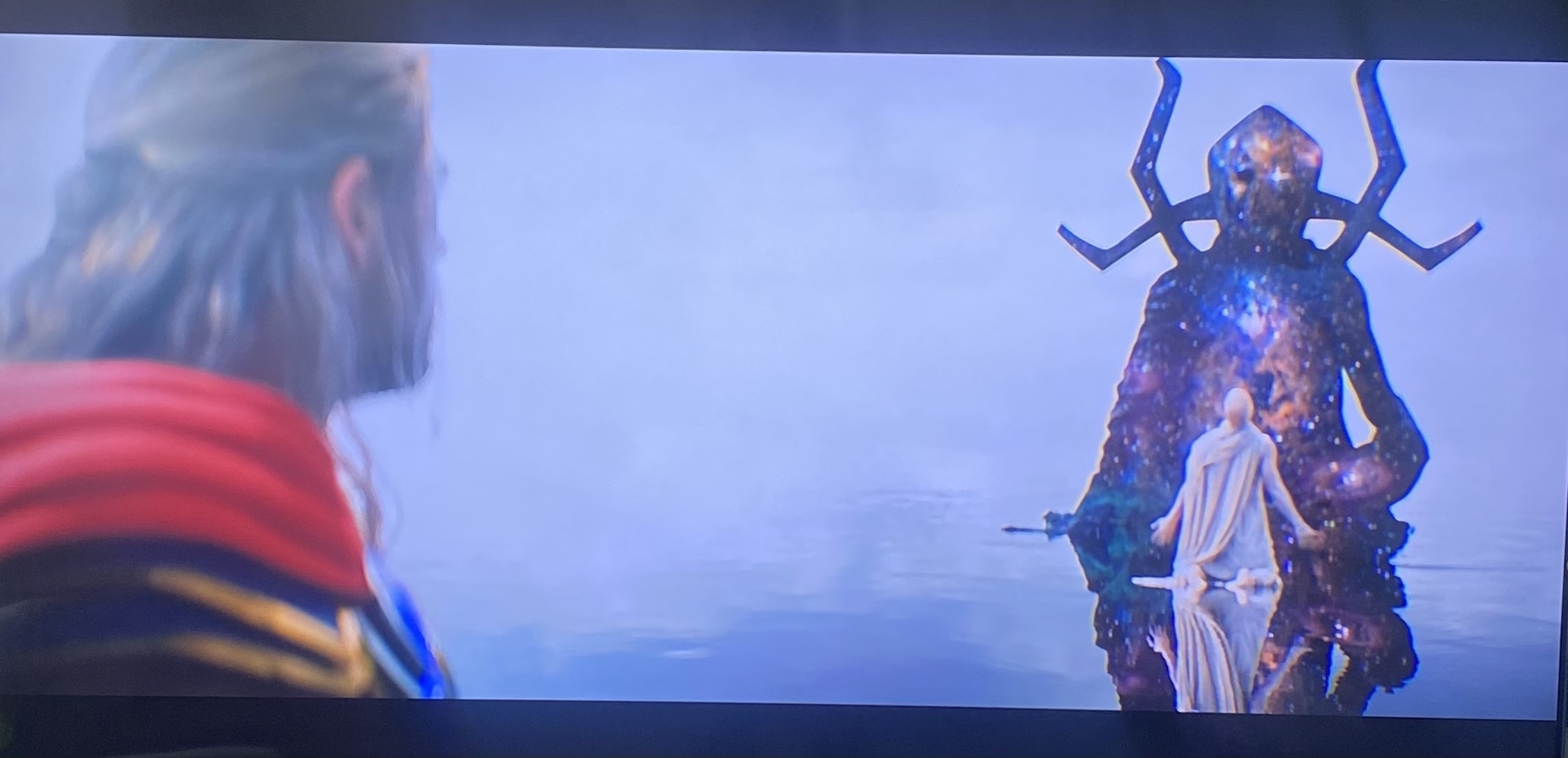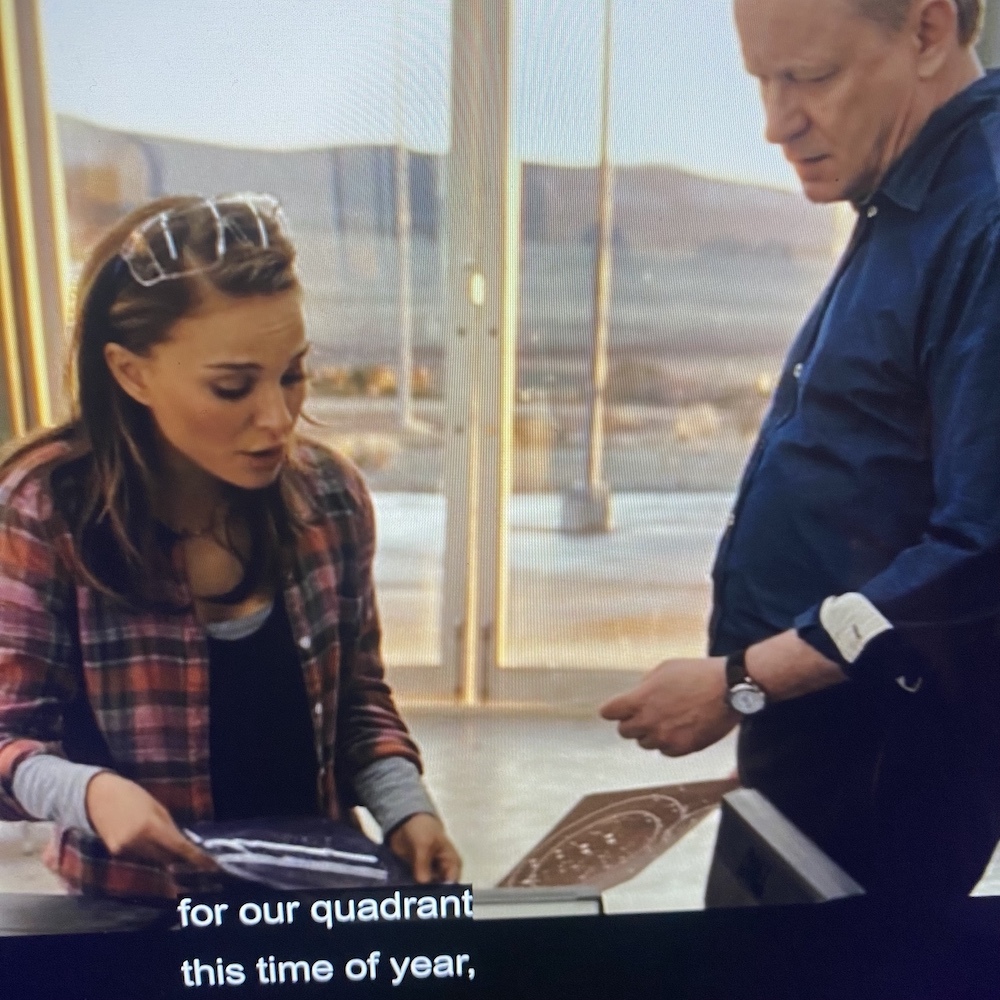- 59
- 8
In Thor 1, Jane refers to the Bifrost as producing gravitational lensing capable of revealing multiple constellations that are native to Asgard's region of space.
Gravitational lensing is a real-world occurrence that astrophysicists use to view otherwise too distant galaxies. Gravitational lensing of the magnitude to reveal multiple constellations -- which at minimum cover hundreds of light years in diameter -- requires at least a small-galaxy-level of mass energy equivalent.
Specifically 140 million solar masses, as explained below.
In Thor 4, Gorr tanked the full pull of the Bifrost for the entire time it was open on the Shadow Realm. This is the only time anyone in the MCU ever fully resisted the full pull of the Bifrost. Meanwhile, Thor fought evenly with Gorr on the Shadow Realm, at one point overpowering Gorr with Stormbreaker's lightning.
This would place Gorr and Thor at galaxy level. This would not affect scaling for any other character, since it occurred after Thor's L&T exercise regimen workout and would place them above the power levels of Loki, Odin, Hela, Malekith, Kurse, Surtur, base Thanos, etc.
---
Thor 1 dialogue:
https://transcripts.foreverdreaming.org/viewtopic.php?t=37719
Between timestamp 33:27 and 34:00, Jane and Erik have this conversation:
ERIK: You don't think this was just a magnetic storm, do you?
JANE: Look, the lensing around these edges is characteristic of an Einstein-Rosen Bridge.
ERIK: An Einstein-Rosen Bridge is a theoretical connection between two different points of space-time.
JANE: It's a wormhole. Erik, look. What do you see?
ERIK: Stars.
JANE: Yeah, but not our stars. See, this is the star alignment for our quadrant this time of year, and unless Ursa Minor decided to take a day off, these are someone else's constellations.
Jane accurately describes gravitational lensing here. The Bifrost operates as a straight line energy beam, positioned directly between Earth (Jane’s point of observation) and Asgard’s region of space which otherwise is too far away even for Earth’s telescopes to view. In this scene, Jane’s telescope is visible.
---
The comic book tie-in Marvel's The Avengers Prelude: Fury's Big Week has Coulson say "the activity has intensified to where there are now atmospheric flares, all of which resulted in large-scale gravitational lensing."
https://books.google.com/books?id=1...in large-scale gravitational lensing"&f=false
---
IRL science / MCU Science:
The Einstein Field Equation (EFE), which is the mathematical basis for both general relativity and gravitational lensing, appeared in Iron Man 2, along with the full derivation of Newton's law of gravity, when Tony Stark was reading Howard's notes, while Tony was actively reading them to try and save his own life. (timestamp 1:13:32 to 1:14:43)
That means these physics exist in the MCU.
https://en.wikipedia.org/wiki/Einstein_field_equations#The_correspondence_principle
"Gravitational lensing occurs when a massive celestial body — such as a galaxy cluster — causes a sufficient curvature of spacetime for the path of light around it to be visibly bent, as if by a lens. The body causing the light to curve is accordingly called a gravitational lens. According to Einstein’s general theory of relativity, time and space are fused together in a quantity known as spacetime. Within this theory, massive objects cause spacetime to curve, and gravity is simply the curvature of spacetime."
https://esahubble.org/wordbank/grav...hen a,accordingly called a gravitational lens.
In Thor 1, Jane references the absence of Ursa Minor when talking about Asgard's constellations. Ursa Minor has stars that are as far apart from each other as 683 light years. The stars in the smallest known real world constellation, Canis Minor, are separated by 138 light years.
https://en.wikipedia.org/wiki/Ursa_Minor#Features
https://en.wikipedia.org/wiki/Canis_Minor#Features
Since Jane said "constellations" plural, at minimum the stars in Asgard's region of space should be taken as double the size of Canis Minor, or 277 light years.
The smallest real world galaxy, the dwarf M60-UCD1, is 154 light years in spatial distance and 140 million solar masses. This is the minimum spatial distance and mass energy equivalent the Bifrost produced.
https://en.wikipedia.org/wiki/M60-UCD1
---
Finally, a corroborating piece of evidence from Thor 1:
The Bifrost produced auroras on Earth while its entire energy beam was light years away, going from Asgard to the other Realms and nowhere near Earth. Jane and Selvig confirm this at the start of the movie with this dialogue (timestamp 1:32 to 2:08):
https://transcripts.foreverdreaming.org/viewtopic.php?t=37719
ERIK: Jane, you can't keep doing this.
JANE: The last 17 occurrences have been predictable to the second.
ERIK: Jane, you're an astrophysicist, not some storm chaser.
JANE: I'm telling you, there's a connection between these atmospheric disturbances and my research. Erik, I wouldn't have asked you to fly out here if I wasn't absolutely sure.
DARCY: Jane? I think you want to see this.
JANE: What is that?
ERIK: I thought you said it was a subtle aurora!
This is the first time Jane and Selvig saw the Bifrost, so all previous 17 occurrences were just auroras during Asgardian trips to other realms.
This happens again at timestamp 1:35:32, when Loki aims the Bifrost from Asgard to Jotunheim.
At timestamp 1:17:15, SHIELD's equipment later detected the Bifrost producing gamma radiation and gravity. (Gravity being needed for gravitational lensing.) In real life, GRB gamma ray bursts generate physical effects on Earth from light years away, and are caused by multi-solar mass supernovas / black holes.
"The energy in gamma-ray bursts is almost incomprehensible: In a few seconds they can emit as much energy as the sun will over its entire 12-billion-year life span."
https://www.scientificamerican.com/...urst-ever-recorded-rattled-earths-atmosphere/
Auroras and magnetic storms come from solar flares.
https://earthobservatory.nasa.gov/features/ProtonOzone
GRB gamma radiation from light years away can produce effects in Earth's atmosphere that resemble solar flare activity."GRB 221009A produced a sudden ionospheric disturbance so significant that it had a solar-flare sized signature on the day-side ionosphere."
https://iopscience.iop.org/article/10.3847/2515-5172/ac9d2f#fnref-rnaasac9d2fbib3
This means that the Bifrost also normally casually produces supernova star level ambient energy.
Gravitational lensing is a real-world occurrence that astrophysicists use to view otherwise too distant galaxies. Gravitational lensing of the magnitude to reveal multiple constellations -- which at minimum cover hundreds of light years in diameter -- requires at least a small-galaxy-level of mass energy equivalent.
Specifically 140 million solar masses, as explained below.
In Thor 4, Gorr tanked the full pull of the Bifrost for the entire time it was open on the Shadow Realm. This is the only time anyone in the MCU ever fully resisted the full pull of the Bifrost. Meanwhile, Thor fought evenly with Gorr on the Shadow Realm, at one point overpowering Gorr with Stormbreaker's lightning.
This would place Gorr and Thor at galaxy level. This would not affect scaling for any other character, since it occurred after Thor's L&T exercise regimen workout and would place them above the power levels of Loki, Odin, Hela, Malekith, Kurse, Surtur, base Thanos, etc.
---
Thor 1 dialogue:
https://transcripts.foreverdreaming.org/viewtopic.php?t=37719
Between timestamp 33:27 and 34:00, Jane and Erik have this conversation:
ERIK: You don't think this was just a magnetic storm, do you?
JANE: Look, the lensing around these edges is characteristic of an Einstein-Rosen Bridge.
ERIK: An Einstein-Rosen Bridge is a theoretical connection between two different points of space-time.
JANE: It's a wormhole. Erik, look. What do you see?
ERIK: Stars.
JANE: Yeah, but not our stars. See, this is the star alignment for our quadrant this time of year, and unless Ursa Minor decided to take a day off, these are someone else's constellations.
Jane accurately describes gravitational lensing here. The Bifrost operates as a straight line energy beam, positioned directly between Earth (Jane’s point of observation) and Asgard’s region of space which otherwise is too far away even for Earth’s telescopes to view. In this scene, Jane’s telescope is visible.
---
The comic book tie-in Marvel's The Avengers Prelude: Fury's Big Week has Coulson say "the activity has intensified to where there are now atmospheric flares, all of which resulted in large-scale gravitational lensing."
https://books.google.com/books?id=1...in large-scale gravitational lensing"&f=false
---
IRL science / MCU Science:
The Einstein Field Equation (EFE), which is the mathematical basis for both general relativity and gravitational lensing, appeared in Iron Man 2, along with the full derivation of Newton's law of gravity, when Tony Stark was reading Howard's notes, while Tony was actively reading them to try and save his own life. (timestamp 1:13:32 to 1:14:43)
That means these physics exist in the MCU.
https://en.wikipedia.org/wiki/Einstein_field_equations#The_correspondence_principle
"Gravitational lensing occurs when a massive celestial body — such as a galaxy cluster — causes a sufficient curvature of spacetime for the path of light around it to be visibly bent, as if by a lens. The body causing the light to curve is accordingly called a gravitational lens. According to Einstein’s general theory of relativity, time and space are fused together in a quantity known as spacetime. Within this theory, massive objects cause spacetime to curve, and gravity is simply the curvature of spacetime."
https://esahubble.org/wordbank/grav...hen a,accordingly called a gravitational lens.
In Thor 1, Jane references the absence of Ursa Minor when talking about Asgard's constellations. Ursa Minor has stars that are as far apart from each other as 683 light years. The stars in the smallest known real world constellation, Canis Minor, are separated by 138 light years.
https://en.wikipedia.org/wiki/Ursa_Minor#Features
https://en.wikipedia.org/wiki/Canis_Minor#Features
Since Jane said "constellations" plural, at minimum the stars in Asgard's region of space should be taken as double the size of Canis Minor, or 277 light years.
The smallest real world galaxy, the dwarf M60-UCD1, is 154 light years in spatial distance and 140 million solar masses. This is the minimum spatial distance and mass energy equivalent the Bifrost produced.
https://en.wikipedia.org/wiki/M60-UCD1
---
Finally, a corroborating piece of evidence from Thor 1:
The Bifrost produced auroras on Earth while its entire energy beam was light years away, going from Asgard to the other Realms and nowhere near Earth. Jane and Selvig confirm this at the start of the movie with this dialogue (timestamp 1:32 to 2:08):
https://transcripts.foreverdreaming.org/viewtopic.php?t=37719
ERIK: Jane, you can't keep doing this.
JANE: The last 17 occurrences have been predictable to the second.
ERIK: Jane, you're an astrophysicist, not some storm chaser.
JANE: I'm telling you, there's a connection between these atmospheric disturbances and my research. Erik, I wouldn't have asked you to fly out here if I wasn't absolutely sure.
DARCY: Jane? I think you want to see this.
JANE: What is that?
ERIK: I thought you said it was a subtle aurora!
This is the first time Jane and Selvig saw the Bifrost, so all previous 17 occurrences were just auroras during Asgardian trips to other realms.
This happens again at timestamp 1:35:32, when Loki aims the Bifrost from Asgard to Jotunheim.
At timestamp 1:17:15, SHIELD's equipment later detected the Bifrost producing gamma radiation and gravity. (Gravity being needed for gravitational lensing.) In real life, GRB gamma ray bursts generate physical effects on Earth from light years away, and are caused by multi-solar mass supernovas / black holes.
"The energy in gamma-ray bursts is almost incomprehensible: In a few seconds they can emit as much energy as the sun will over its entire 12-billion-year life span."
https://www.scientificamerican.com/...urst-ever-recorded-rattled-earths-atmosphere/
Auroras and magnetic storms come from solar flares.
https://earthobservatory.nasa.gov/features/ProtonOzone
GRB gamma radiation from light years away can produce effects in Earth's atmosphere that resemble solar flare activity."GRB 221009A produced a sudden ionospheric disturbance so significant that it had a solar-flare sized signature on the day-side ionosphere."
https://iopscience.iop.org/article/10.3847/2515-5172/ac9d2f#fnref-rnaasac9d2fbib3
This means that the Bifrost also normally casually produces supernova star level ambient energy.

